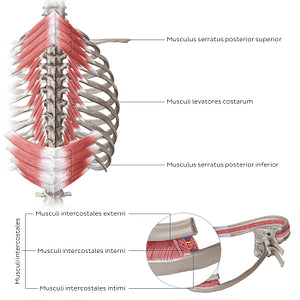Paul Kim
Muscles of thoracic wall (Posterior view) (Latin)
Muscles of thoracic wall (Posterior view) (Latin)
The mm. interni of the paries posterior thoracis can be better appreciated from this view. The m. serratus posterior superior and m. serratus posterior inferior (right) are two paired muscles located in the upper and lower back. Their main function is to facilitate the act of respiration; the m. serratus posterior superior elevates the costae, while the m. serratus posterior inferior depresses the costae. The mm. levatores costarum consists of 12 small triangular bilateral muscles that connect the vertebrae thoracicae with the adjacent costae. This group of muscles functions in elevating the costae to facilitate forced inspiration and produces rotation and lateral flexion of the vertebrae thoracicae.The mm. intercostales externi, mm. intercostales interni and mm. intercostales intimi can also be appreciated from a posterolateral view of the thoracic cage (left). The mm. intercostales externi are the most superficial mm. intercostales; their fibers are oriented in an inferomedial direction. The mm. intercostales interni form the middle layer of the intercostal musculature; their fibers course inferolaterally. The mm. intercostales intimi are the deepest mm. intercostales and course in the same manner as the mm. intercostales interni. All three mm. intercostales are accessory respiratory muscles that participate in the process of forced breathing.
Preço normal
$7.56 USD
Preço normal
Preço promocional
$7.56 USD
Preço unitário
por
Não foi possível carregar a disponibilidade de retirada.


#C79437
#AA615F
#9D3736
#523832
#E4928F e #CFAFAD

